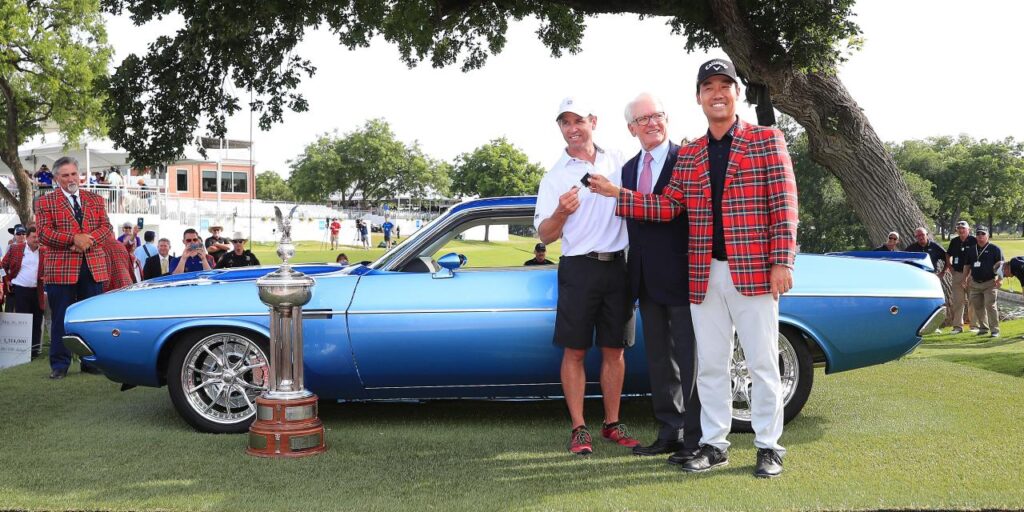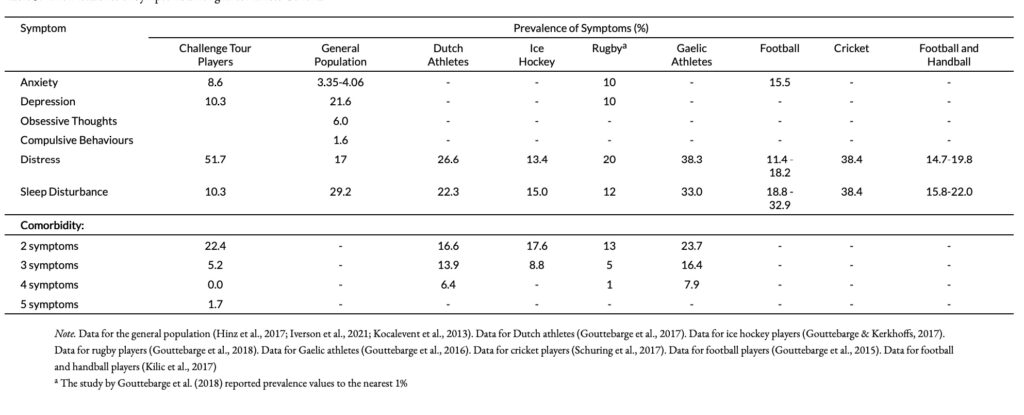
Million-dollar payouts.
Flying in Private Jets.
Fame.
Traveling around the globe for his job.
While fans are quick to spot the glamorous aspects of Tiger Woods’s life, they often overlook the mental and physical health struggles he has faced in his career.
Golf has its own, distinct set of challenges, irrespective of whether you are a world-renowned golfer or a mini-tour pro. Golfers are independent contractors who have to fend for every cent they make while navigating feelings of loneliness, distress, and homesickness that comes with living on the road (Fry and Bloyce 2015: 336).

SO WHY FOCUS ON GOLF?
Symptoms of anxiety, distress, and OCD are significantly higher for challenge tour players than for the general population. Further, the prevalence of symptoms of distress for golfers seems to be significantly higher than for any other sport (Hopley et al., 2022: 6).
Table 1: Professional golfers experience higher levels of anxiety, distress, and OCD than the general population.

GOLF AS A GLOBAL SPORT
Golf is a global sport that often requires professional golfers to be away from their loved ones for months. This makes them extremely susceptible to burnout. For instance, more than half of the European Professional Golfers Association (EPGA) tour itinerary is staged outside of Europe, while other tournaments still require travel (Fry and Bloyce 2015: 337). Golfers, as a result, spend a large portion of their time away from home.
Only a handful of touring golfers travel with their families because being with family is not only distracting but logistically difficult to plan. Golfers play at minimum five six-hour rounds every week and typically spend their time between rounds, working on their swing with their coach, with a touring physiotherapist managing injuries, or analyzing their strategy for the day with their caddy. With all these critical daily tasks at hand, golfers have negligible time or energy to call their family or friends on a regular basis when away. These factors can have a huge toll on them mentally (Fry and Bloyce 2015: 346).
GOLF AS AN INDIVIDUAL SPORT
Unlike athletes in team sports, golfers don’t have teammates to be entertained, motivated, and supported by through the season. Professional golfers travel with their caddy, coach, and physiotherapist but their relationships are largely professional. To navigate loneliness and boredom while on the road, golfers often befriend other professionals on similar accounts as them. Golfers may form alliances with other professional golfers to prevent hostility toward them (Fry and Bloyce 2015: 340). This causes the players to suppress their actual emotions which could look like putting on a positive front to colleagues in the face of a string of bad performances (Fry and Bloyce 2015: 355).
Competing alone, individual sports athletes also experience the weight of their performances alone (Nixdorf et al., 2016). On one hand, this means that golfers feel more satisfaction after good performances than team-sport athletes do (Hanrahan and Biddle, 2008). On the other hand, they feel significantly higher feelings of guilt and shame after bad performances than their counterparts (Tracy and Robins, 2004).
Furthermore, most friendships are nonpermanent and circumstantial. There is always a looming sense of tension in the friendship as they are ultimately in direct competition with each other for a share of the overall prize money. One player revealed that if he were to discuss his problems with other players, “half of them would be happy and the other half wouldn’t care,” (Fry and Bloyce, 2015). This highlights how superficial friendships among professional golfers really are.
TYING IT ALL TOGETHER
Tiger Woods, one of the greatest individual sport athletes to ever live, has experienced endless mental health struggles through slumps, injuries, and navigating his identity. While people may be quick to blame him for his shortcomings, most people don’t see the challenges of being a professional golfer behind the cameras. Professional golfers end up spending their entire careers blaming themselves for experiencing feelings of loneliness and distress. This is where professional golf tours need to step in. By simply reducing the intensity of their schedule, therefore, allowing golfers to spend more time with their families, and offering access to trained sports psychologists while golfers are on the road they will begin to alter the alienating structure of the game. Ultimately, professional golfers will benefit from acknowledging that their personal experiences of stress and strain are a very small subset of the experiences the structure of an individual sport like golf causes to all those playing it professionally.
BIBLIOGRAPHY
Fry, John, and Daniel Bloyce. “‘Friends as enemies’: A sociological analysis of the relationship among touring professional golfers.” International Review for the Sociology of Sport 52.3 (2017): 336-360
Hopley, Georgia, Andrew Murray, and Alan MacPherson. “The prevalence of symptoms of common mental disorders among professional golfers.” International Journal of Golf Science. 2022 Sep 30.
Nixdorf I., Frank R., Beckmann J. Comparison of athletes’ proneness to depressive symptoms in individual and team sports: research on psychological mediators in junior elite athletes. Frontiers in Psychology, vol 7, 893, 2016.
Hanrahan S. J., Biddle S. J. “Attributions and perceived control,” in Advances in Sport Psychology, 3rd Edn, ed. Horn T. (Champaign, IL: Human Kinetics; ), 99–114, 2008.
Jessica L. Tracy & Richard W. Robins. “Putting the Self Into Self-Conscious Emotions: A Theoretical Model”, Psychological Inquiry, 15:2, 103-125, 2004.